Christmas Week in Santiago - after a long, long walk and no cheating
Alan Sykes (The Guardian Blogs) celebrates with his feet up, after walking 1000km (621 miles) from
Seville to the pilgrimage city. In his final despatch for the Northerner, he savours the odour of sanctity in the cathedral from a huge incense-burner swung by eight men
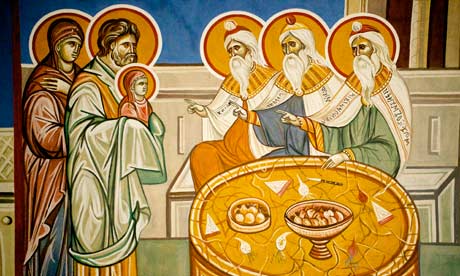
Alan Sykes has travelled a long way but found the journey very worthwhile. Photograph: Christopher Thomond for the Guardian
On arriving in Santiago, one of the first things most pilgrims do is head for the pilgrim welcome office to pick up their compostela,
the official recognition that you've walked to Santiago, complete with
the seal of "capituli Beati Jacobi". The staff check the stamps in your
credencial, or pilgrim passport, to check that you've really
done the required amount – some people apparently do try to cheat,
astonishingly. They then issue you with a Latin document to prove your
arrival.
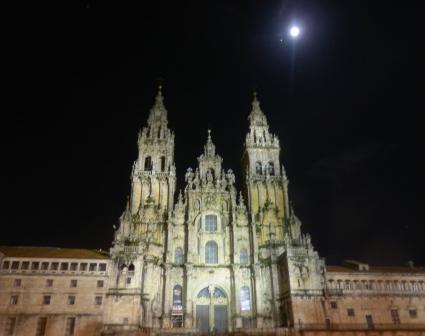 Jupiter in conjunction with the moon over Santiago Cathedral at Christmas
At the beginning of the pilgrims' mass in the cathedral each day, the
number of pilgrims to have recently arrived is read out. So I was
pleased to hear, among the 24 Christmas Eve arrivals, of the achievement
of
Jupiter in conjunction with the moon over Santiago Cathedral at Christmas
At the beginning of the pilgrims' mass in the cathedral each day, the
number of pilgrims to have recently arrived is read out. So I was
pleased to hear, among the 24 Christmas Eve arrivals, of the achievement
of
On Christmas Day, they swung the botafumeiro. This is believed to be the biggest incense censer in the world, weighing 80kg. In the middle ages, the incense was used partly, it is said, to cover up the smell of the unwashed pilgrims. Eight men use a system of ropes to swing it up to 100 yards from the north to the south transepts of the cathedral.
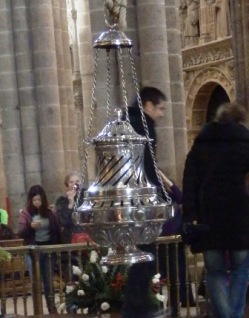 The cathedral's huge incense burner, the Botafumeiro
This year, around 192,000 people from 157 countries claimed their compostela,
having walked at least the last 100km to the tomb. About 70% walked
some or all of the Camino Francés from the Pyrenees, while 4% used the
Via de la Plata. The 2011 release of the film "The Way",
starring Martin Sheen, is being credited with almost doubling the
number of Americans making the camino, from 3700 in 2011 to over 7000
this year.
The cathedral's huge incense burner, the Botafumeiro
This year, around 192,000 people from 157 countries claimed their compostela,
having walked at least the last 100km to the tomb. About 70% walked
some or all of the Camino Francés from the Pyrenees, while 4% used the
Via de la Plata. The 2011 release of the film "The Way",
starring Martin Sheen, is being credited with almost doubling the
number of Americans making the camino, from 3700 in 2011 to over 7000
this year.
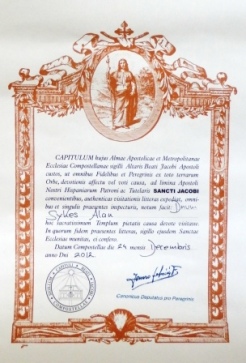 Compostela issued on 24 December 2012.
John Walker, a volunteer at Santiago cathedral's office of pilgrim
welcome, is convinced the film has had an effect on numbers: "it's not
just American numbers which are up, this year we've also seen very
significant increases in the number of pilgrims coming from the UK as
well as from virtually all the main English-speaking countries,
including Australia, New Zealand and Canada."
Compostela issued on 24 December 2012.
John Walker, a volunteer at Santiago cathedral's office of pilgrim
welcome, is convinced the film has had an effect on numbers: "it's not
just American numbers which are up, this year we've also seen very
significant increases in the number of pilgrims coming from the UK as
well as from virtually all the main English-speaking countries,
including Australia, New Zealand and Canada."
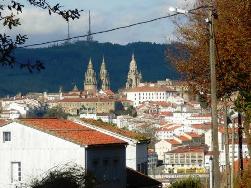 The towers of Santiago Cathedral as viewed from the suburbs on the pilgrim way
Santiago is where many believe Spain's
patron saint, the apostle St James the Great (Santiago), is buried. A
tomb believed to be his was discovered in 881AD, and quickly became a
major centre for pilgrimage. The cathedral was built over the supposed
tomb of the apostle over the next centuries. Some years before the
discovery of the tomb, in 844AD, Santiago is supposed to have appeared
in person at the Battle of Clavijo,
where the Christian Spaniards defeated the Muslim forces of the Emir of
Cordóba during the Christian "reconquista" of Spain. Later accounts
claim that Santiago participated in the battle, personally killing many
of the enemy troops, and earning himself the title of Matamoros, or "the moor-slayer."
The towers of Santiago Cathedral as viewed from the suburbs on the pilgrim way
Santiago is where many believe Spain's
patron saint, the apostle St James the Great (Santiago), is buried. A
tomb believed to be his was discovered in 881AD, and quickly became a
major centre for pilgrimage. The cathedral was built over the supposed
tomb of the apostle over the next centuries. Some years before the
discovery of the tomb, in 844AD, Santiago is supposed to have appeared
in person at the Battle of Clavijo,
where the Christian Spaniards defeated the Muslim forces of the Emir of
Cordóba during the Christian "reconquista" of Spain. Later accounts
claim that Santiago participated in the battle, personally killing many
of the enemy troops, and earning himself the title of Matamoros, or "the moor-slayer."
Clearly in the eight centuries since his martyrdom the fisherman had become an expert soldier and rider. Many sculptures and pictures throughout Spain depict him on horseback, armed with a sword and spear, with decapitated and injured bodies of the moors he has killed sprawled on the ground beneath. When General Franco appointed his Moroccan lieutenant Mohammed ben Mizzian as Captain-General of Galicia after the Spanish civil war, the cathedral authorities reputedly found it tactful to cover up or remove some of the gorier depictions of Santiago Matamoros. Today one of the most famous – and goriest - an 18th century sculpture of St James fully armed on a white charger, is on display, but a large bank of flowers obscures the dead and dying moors beneath his horse's feet.
Alan Sykes, the Guardian Northerner's arts expert and much else besides, has marched 1000km (621 miles) in the last month to Santiago de Compostela to expiate unknown sins. He's sent us ten previous reports and you can read them all here. He also took the photographs. As he nurses his feet, why not send him a Christmas Week Tweet: @geltsdale
 Alan will be back on his arts beat for the Northerner in the New Year.
Alan will be back on his arts beat for the Northerner in the New Year.
Here is a map of his route - the Via de la Plata from Seville - courtesy of www.santiago-compostela.net, an excellent website which has lots of information on all the pilgrim routes. Posted by Alan Sykes
 Jupiter in conjunction with the moon over Santiago Cathedral at Christmas
At the beginning of the pilgrims' mass in the cathedral each day, the
number of pilgrims to have recently arrived is read out. So I was
pleased to hear, among the 24 Christmas Eve arrivals, of the achievement
of
Jupiter in conjunction with the moon over Santiago Cathedral at Christmas
At the beginning of the pilgrims' mass in the cathedral each day, the
number of pilgrims to have recently arrived is read out. So I was
pleased to hear, among the 24 Christmas Eve arrivals, of the achievement
ofOn Christmas Day, they swung the botafumeiro. This is believed to be the biggest incense censer in the world, weighing 80kg. In the middle ages, the incense was used partly, it is said, to cover up the smell of the unwashed pilgrims. Eight men use a system of ropes to swing it up to 100 yards from the north to the south transepts of the cathedral.
 The cathedral's huge incense burner, the Botafumeiro
This year, around 192,000 people from 157 countries claimed their compostela,
having walked at least the last 100km to the tomb. About 70% walked
some or all of the Camino Francés from the Pyrenees, while 4% used the
Via de la Plata. The 2011 release of the film "The Way",
starring Martin Sheen, is being credited with almost doubling the
number of Americans making the camino, from 3700 in 2011 to over 7000
this year.
The cathedral's huge incense burner, the Botafumeiro
This year, around 192,000 people from 157 countries claimed their compostela,
having walked at least the last 100km to the tomb. About 70% walked
some or all of the Camino Francés from the Pyrenees, while 4% used the
Via de la Plata. The 2011 release of the film "The Way",
starring Martin Sheen, is being credited with almost doubling the
number of Americans making the camino, from 3700 in 2011 to over 7000
this year. Compostela issued on 24 December 2012.
John Walker, a volunteer at Santiago cathedral's office of pilgrim
welcome, is convinced the film has had an effect on numbers: "it's not
just American numbers which are up, this year we've also seen very
significant increases in the number of pilgrims coming from the UK as
well as from virtually all the main English-speaking countries,
including Australia, New Zealand and Canada."
Compostela issued on 24 December 2012.
John Walker, a volunteer at Santiago cathedral's office of pilgrim
welcome, is convinced the film has had an effect on numbers: "it's not
just American numbers which are up, this year we've also seen very
significant increases in the number of pilgrims coming from the UK as
well as from virtually all the main English-speaking countries,
including Australia, New Zealand and Canada." The towers of Santiago Cathedral as viewed from the suburbs on the pilgrim way
Santiago is where many believe Spain's
patron saint, the apostle St James the Great (Santiago), is buried. A
tomb believed to be his was discovered in 881AD, and quickly became a
major centre for pilgrimage. The cathedral was built over the supposed
tomb of the apostle over the next centuries. Some years before the
discovery of the tomb, in 844AD, Santiago is supposed to have appeared
in person at the Battle of Clavijo,
where the Christian Spaniards defeated the Muslim forces of the Emir of
Cordóba during the Christian "reconquista" of Spain. Later accounts
claim that Santiago participated in the battle, personally killing many
of the enemy troops, and earning himself the title of Matamoros, or "the moor-slayer."
The towers of Santiago Cathedral as viewed from the suburbs on the pilgrim way
Santiago is where many believe Spain's
patron saint, the apostle St James the Great (Santiago), is buried. A
tomb believed to be his was discovered in 881AD, and quickly became a
major centre for pilgrimage. The cathedral was built over the supposed
tomb of the apostle over the next centuries. Some years before the
discovery of the tomb, in 844AD, Santiago is supposed to have appeared
in person at the Battle of Clavijo,
where the Christian Spaniards defeated the Muslim forces of the Emir of
Cordóba during the Christian "reconquista" of Spain. Later accounts
claim that Santiago participated in the battle, personally killing many
of the enemy troops, and earning himself the title of Matamoros, or "the moor-slayer." Clearly in the eight centuries since his martyrdom the fisherman had become an expert soldier and rider. Many sculptures and pictures throughout Spain depict him on horseback, armed with a sword and spear, with decapitated and injured bodies of the moors he has killed sprawled on the ground beneath. When General Franco appointed his Moroccan lieutenant Mohammed ben Mizzian as Captain-General of Galicia after the Spanish civil war, the cathedral authorities reputedly found it tactful to cover up or remove some of the gorier depictions of Santiago Matamoros. Today one of the most famous – and goriest - an 18th century sculpture of St James fully armed on a white charger, is on display, but a large bank of flowers obscures the dead and dying moors beneath his horse's feet.
Alan Sykes, the Guardian Northerner's arts expert and much else besides, has marched 1000km (621 miles) in the last month to Santiago de Compostela to expiate unknown sins. He's sent us ten previous reports and you can read them all here. He also took the photographs. As he nurses his feet, why not send him a Christmas Week Tweet: @geltsdale
 Alan will be back on his arts beat for the Northerner in the New Year.
Alan will be back on his arts beat for the Northerner in the New Year.Here is a map of his route - the Via de la Plata from Seville - courtesy of www.santiago-compostela.net, an excellent website which has lots of information on all the pilgrim routes. Posted by Alan Sykes

No hay comentarios:
Publicar un comentario